Hands rest inside my jacket. Zippered pockets and wool glove inserts nestle them away from the growing chill of a clearing sky. Loowit gleams as I stand in solid shadow. The forest begins a few meters to my rear, a short section of dense trees that quickly accedes to the eastern bulwark of Goat Mountain’s mass. I rock back and forth on bootied feet in a small snow pit, waiting for the transit. I have sat silent for four hours.

A steady train of thoughts rumble along. The usual bubbling incoherence. Big thoughts and small thoughts. A wondering about the coming cold of the night. An awareness of the slow leak of heat through my feet into the compacted snow underneath. The realization that I have likely now done this more times than I will be able to again. The fuel canister presses against my belly, warming itself into usefulness inside my dingy down jacket. A reminder to stave off the cramps, to drink.
Another bubbling drifts into awareness. A trickle of water that belies the cold. Invisible under the snow, the trickle joins a network of rivulets undergirding the marsh. A slow-forming, tributary, Toutle headwater, the water of the marsh gently wanders through the red-iron soil before it cuts the Fossil Creek Trail and begins its plunge downhill. The bubbling folds into the flow, disappearing into the stream of information that smothers my senses. My metronome mind switches streams in the ceaseless rapid ticks that form our conscious thought. Water, snow, time, cold, clouds, light. Goat Mountain’s evening shadow spans the white expanse, rests against the domes.
The bubbling fades as my eyes follow the shadow, coalescing into an eventual stare at a green splotch-tip atop the south dome. A surprise meadow and a view. The domes are a patchwork eden of beargrass, rock, and stands of fir. Vine maple chokes the steep path into a Secret Garden. I think on a warm night, ten summers gone, perched cliff-side on the north dome’s mountain facing flank.
Cloud bands appear over the southeast-running, spiny ridge behind me. They flow high above the rocky points. I watch as the bands drift east. I judge their density, wonder at the moonrise’s viability. The sky is slowly clearing, though. A massive, amber beam of sunset wraps past Goat’s northern ridge. It dominates the snowy expanse far to my left, painting a warm yellow spotlight on the squat ridge that separates Goat Marsh from Blue Lake. The sun, like Goat’s shadow, points a sight line. A small rock bluff stands out in the sun, orange against a canvas of dark-fading, blue-green. The metronome beats, the bluff holds my focus another measure.
Along the line of my gaze another pattern emerges in the foreground, at my feet. A visual staccato of elk prints punched in the grey-shadowed snow drifts away east. They melt into the brewing dusk. The prints recall the contact with elk a few hours before. Twenty animals lazing in the afternoon snow. They, mostly, lay in a comfortably cautious afternoon catatonia brought on by their own metronome of diurnal rhythms. I had approached to within two hundred meters, surprised at their lack of awareness of my silhouette’s movement across the blank snow. They have spent the mild winter unmolested. An insight into their life, backstage.
Reaching the spur, I took advantage of the concealment to perform a flurry of silent motion; camera readied, lens switched, pack back in place. A slow slicing of the corner on silent skis. Gently easing forward, the progressive sweeping lateral horizon of my view reveals them still seated. A few hasty shutter snaps later and my movement is noticed. The herd bounces up and trundles off, a single juvenile bull falling in at the rear.
The herd is gone now. They had spent the remaining afternoon hours browsing around the northern marsh as I puttered, set up my camp. Another spook, and their heads turned, in unison, towards the western tree line, to a spot hundreds of meters to my left. The metronome beat once, and they trundled off again, this time disappearing for good, into the uniform mass of scrub trees that slowly ascends, past the road, towards the mountain. I am now alone.
It is silent a while. I puncture it with my stove-roar. A few minutes, and I silence that too. The suddenness of the stove’s silence is jarring. An auditory equivalent to a sight-shock that stops the breath. It highlights the patience, out here. The rocks simply sit, the trees stand. Morning, through morning, through morning. A thousand dawns, tides of snow come and go. Ten thousand, and the trees stand taller, some die. A rock falls into a pile, a storm traces a new gully. Geological time.
In this space I am at rest. The rightness of my belonging rises up, into awareness. It is a feeling, supra-emotional, that is more intuitive than affective. It is the hunch, the sensing of knowledge. Knowledge that rationality will, with time, parse into clean definitions and proofs. In this space I am at rest. There is no desire to move. It is right, here. The trickle bubbles, and my feet leak heat. The amber shaft shines, my back aches, and my mind marks the time. Connectivity gleams.
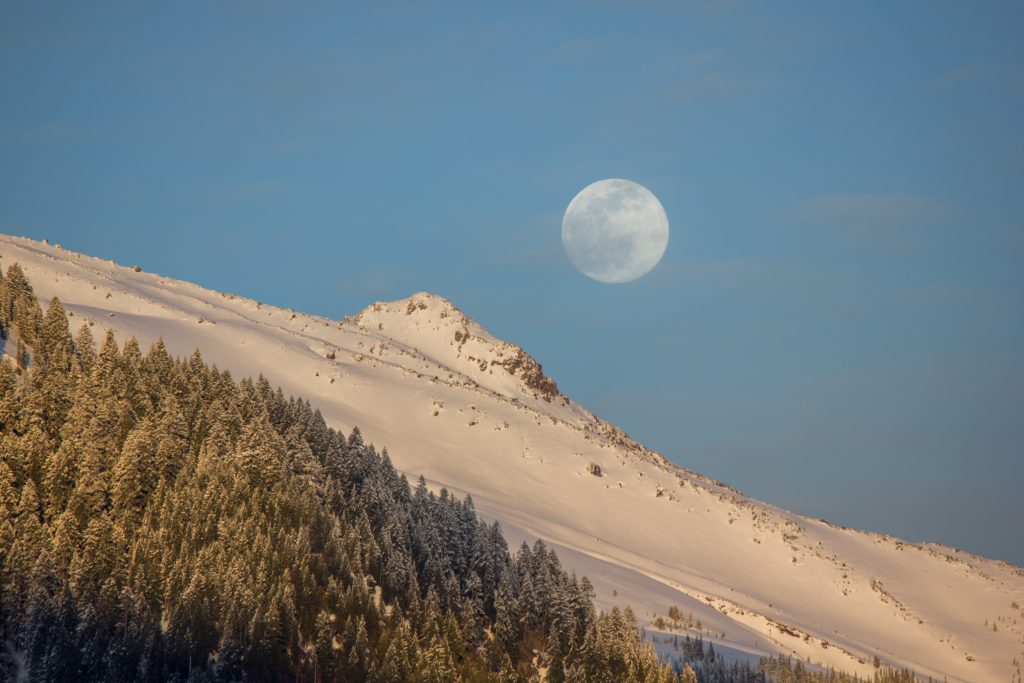
And then the moon is there. The awareness shock. It is unlike the dawn, the moonrise. There is no prelude. I turn, and it is there. The Worm Moon, a super moon. It is silent as it transits Monitor Rock. I stand, paused in an ominous feeling of wonder. Why does it make no noise? The eeriness of the silence is familiar, reminds of the awe felt, standing under the rolling, flashing, silent-thunderclap of the Aurora Borealis. Raw nature unfolding. It has no need to shout. A confident blue-tinged, white-grey, near third-again brighter than an average full, this moon commands attention.
Activation ends my reverie. The moon moves surprisingly fast. A pause-breath shows it sliding past, up and away from, the rock. I switch lenses, adjust compositions, and bracket exposures in a flurry of shutter snaps. I am trying to control the moment, capture a view, a feeling, really. Preserve a perspective which can be packaged and prepared, published later in a way, just so, that brings the reader here. In thirty minutes I accede this foolishness, I have captured all I can.
The evening hue slowly darkens. The clearing sky and drying air draw a lazy, smoky fog up off the snowfield. Venus winks on, joined by Andromeda and Polaris, as the metronome beats on. I am fully tuned in, again. The flurry is over, being has taken over from doing. The natural trance of awareness silences my inner thought. My mind sees patterns, absorbing details which link me to the scene. The silence, the starlight, the cold on my face. The bursting coyote bark, and the owl-pair call and response.

We are programmed to be in tune with these patterns. They are a natural stimulation which have a calming, centering affect on us. Neurologically, natural scenes influence our minds in ways that can balance the impact of our ordinarily screen-driven, indoor, consumer lives.
As ecopsychology writer Laura Sewall explains, sensory encounters with natural scenes illicit an inborn process of neuroplasticity in adult brains. While the brains of children are inherently moldable and ready to learn new things, adults tend to only see new patterns when they find something surprising or if they intentionally engage in mental focus. Immerse an adult in an ecological setting, however, and neurological processes begin to refine their mental schema, loosening fixed assumptions and allowing it to account for new patterns. Nature opens the mind.
Interestingly, Rachel and Steven Kaplan, a married pair of scientists, have shown that this mind-opening encounter calms us as well. Urban environments, and natural ones as well, broadcast an overwhelming amount of sensory information. In nature, our brains respond to this sensory overload much differently, however. Man-made scenes tend to overstimulate us, causing our brains to block most of the information in an effort to lower our stress response. Natural settings, in contrast, encourage our attention. The roll and shift of clouds, bird chatter, rain patter, wind moan, and tree rustle coalesce into a beautiful harmony which resonates deeply in us, lowering our distress. Nature soothes the mind.
A sheen of frost coats the top of my bag where my feet have spent the night. It was just cold enough to freeze some my body moisture as I desiccated throughout the night. The sheen splinters and falls into white-sandy snow bursts when I stuff the bag into my pack. The frost is thicker, obvious, on the single wall of my pyramid tent. The packing takes some time; due to my dawdling, indecision as to go for a ski or pack, but mostly because I must spend minutes rewarming my hands after each task.
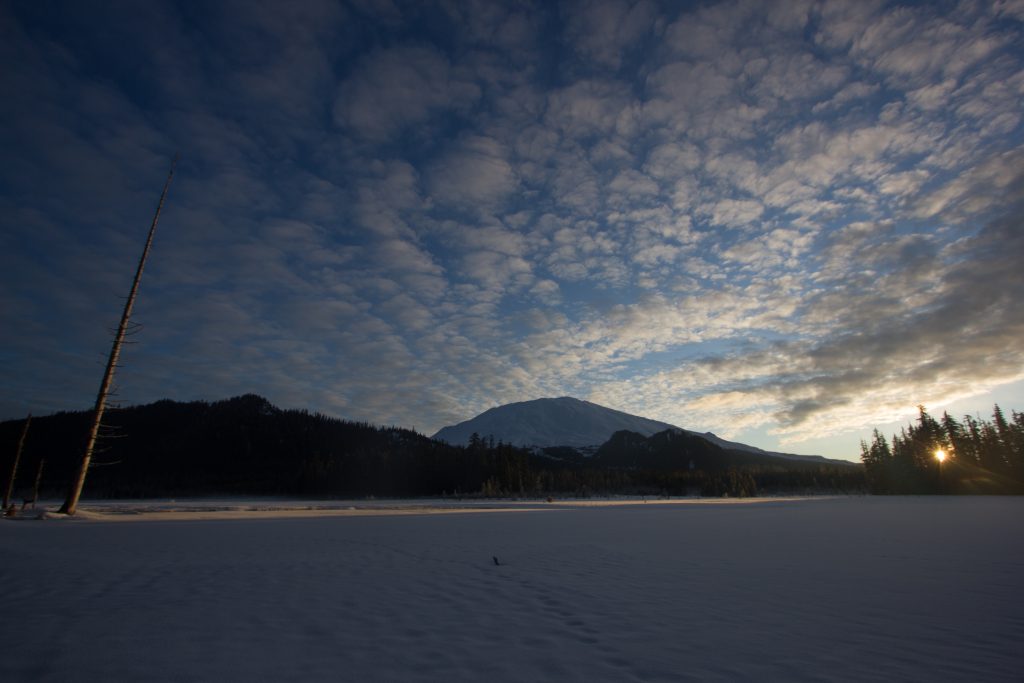
The amber shafts are reversed now, the sunrise wrapping around a far patch of trees to throw a yellow-red beam on the spiny ridge just to my right. The dawn shadow edge between us will take another forty minutes to reach me. I envy the ridge its warmth. I pause packing to stand and snap shots, watching the sky above Monitor Ridge slide to brilliant yellow-white. Shadows and highlights appear among the riffles of ridges and draws on Mt. St. Helens. Texture emerging out of the shadowed grey. The yellow-white intensifies along two parallel amber shafts that illuminate the marsh on either side of me. Rough-grain crystals coat the top of the snow, obvious in the dawn.
The snow is freshly crusted. It almost supports my steps. My tripod sticks, must be dug out. The bubbling trickle is still. All else is quiet. The night cold slows life. I continue my halting repack, free my skis from their duty as tent stakes.
Birdsong breaks the silence. Those hardy fellows with their naked feet. The day is here, now, and we are ready. The birds are chirping the spring. A day, a season, a lifetime, an epoch; all synchronize spin. Like a gear assemblage, moving at their different speeds. All towards the same end. The metronome beats time, and the patterns eventually harmonize. I heed the birds, stand on skis, pack in place. The sun shifts, its shadows shift. The clouds drift. I breathe, having found my place in time.

I keep my puffy on. The morning is still chill as I depart the tent site. This ski will be a slow survey, a contemplative circumnavigation of the marsh. I must preserve my heat for the photo stops, the points where I will pause and ponder.
The bubbling trickle steadily swells as the rivulet forms into a small creek that follows the faintly perceptible slope that drains the marsh north. A spidery web of rivulets, most under the snow, span throughout the marsh, all eventually joining the main steam that loosely traces Goat Mountain’s eastern flank. The main stream is already running proud, steady-faint flashes of translucent silver flowing out from below decaying ice. Come June, this will be a bog. Today, I glide alongside, on firm snow. Snowbanks, white in their purity, layer over the burgundy of the ferrous clay of the creek bed. On skis, I am my own drone, flying effortlessly over land that is all but impassable after breakup.
Brown spots creep against the white. It is the same hardy herd of elk, again. Morning is feeding time for them, a daily ritual they repeat twice, with a nap in between. I pause and watch, a bit more than a quarter mile off. No heads turn my way. The elk are calmly meandering through the scrub at the farthest north reaches of the marsh. The herd has fanned out, unconcerned. I consider a silent stalk to slip up for a photo. Inevitably I would bump them, though, break up their brunch with a moment of terror. I smile, and spin around instead, leaving them their peace. This is the end of their seasonal respite. In weeks, the road will melt out, and the marsh will no longer be nature, sans man.
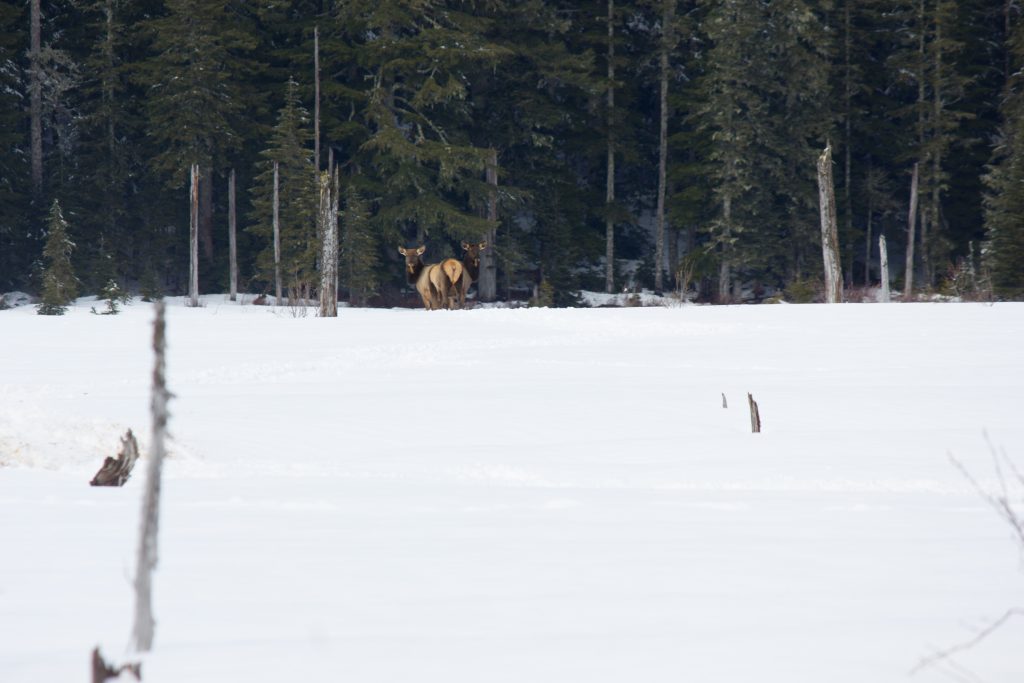
The spring melt necessitates long detours around muddy rivulets. I end up zigzagging nearly back to the tent site as I ski out. The sun is in high morning as I approach the ridge spur corner from yesterday. The snow reflects the bright. I am warm, and doff the puffy. Ravens fly over, periodically, seemingly randomly; their edonking croaks announce my intrusion, my stranger’s presence, to the entire west side.
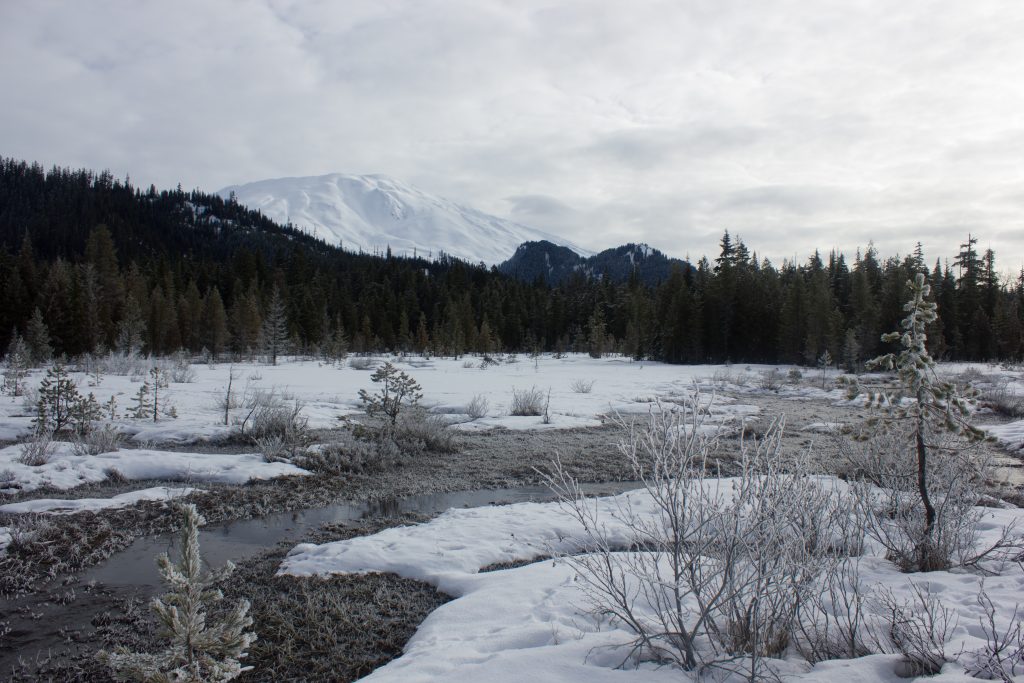
The dark edge of trees drifts closer as I move south. I can feel the pregnant hesitation, the reluctance, that comes with an approaching goodbye. A few feet from the edge, I pause to look back, give a last wistful glance. In a few seconds the dark-moody forest will swallow me away from this space. So I look back, once more, to remember this place; a proud Goat Mountain towering over a silent, gleaming-white Goat Marsh. A murmured thank you, to the marsh, for I am grateful for having watched, this moment in time.

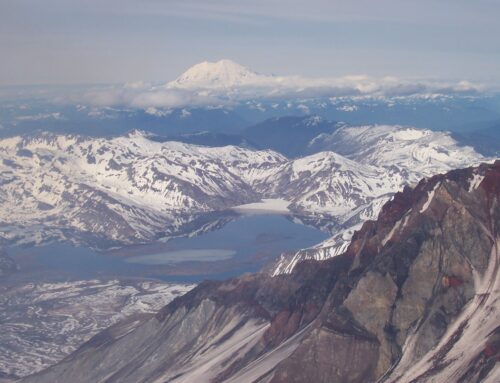
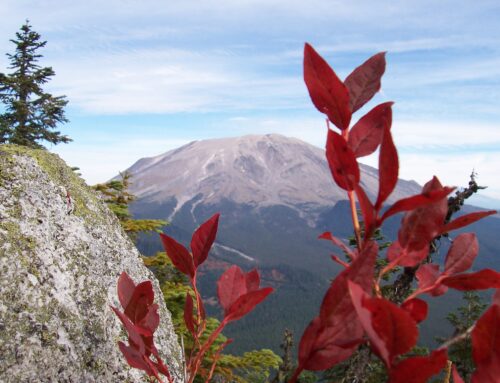
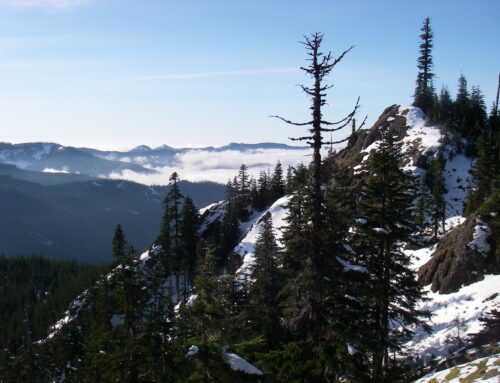
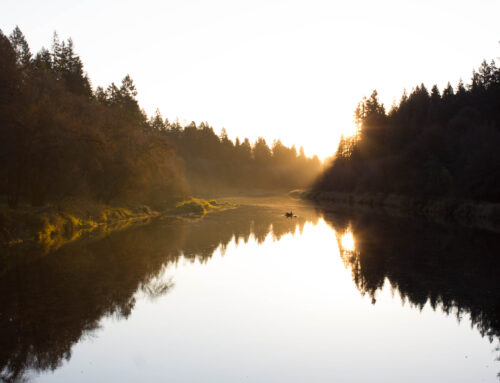
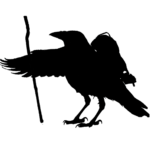
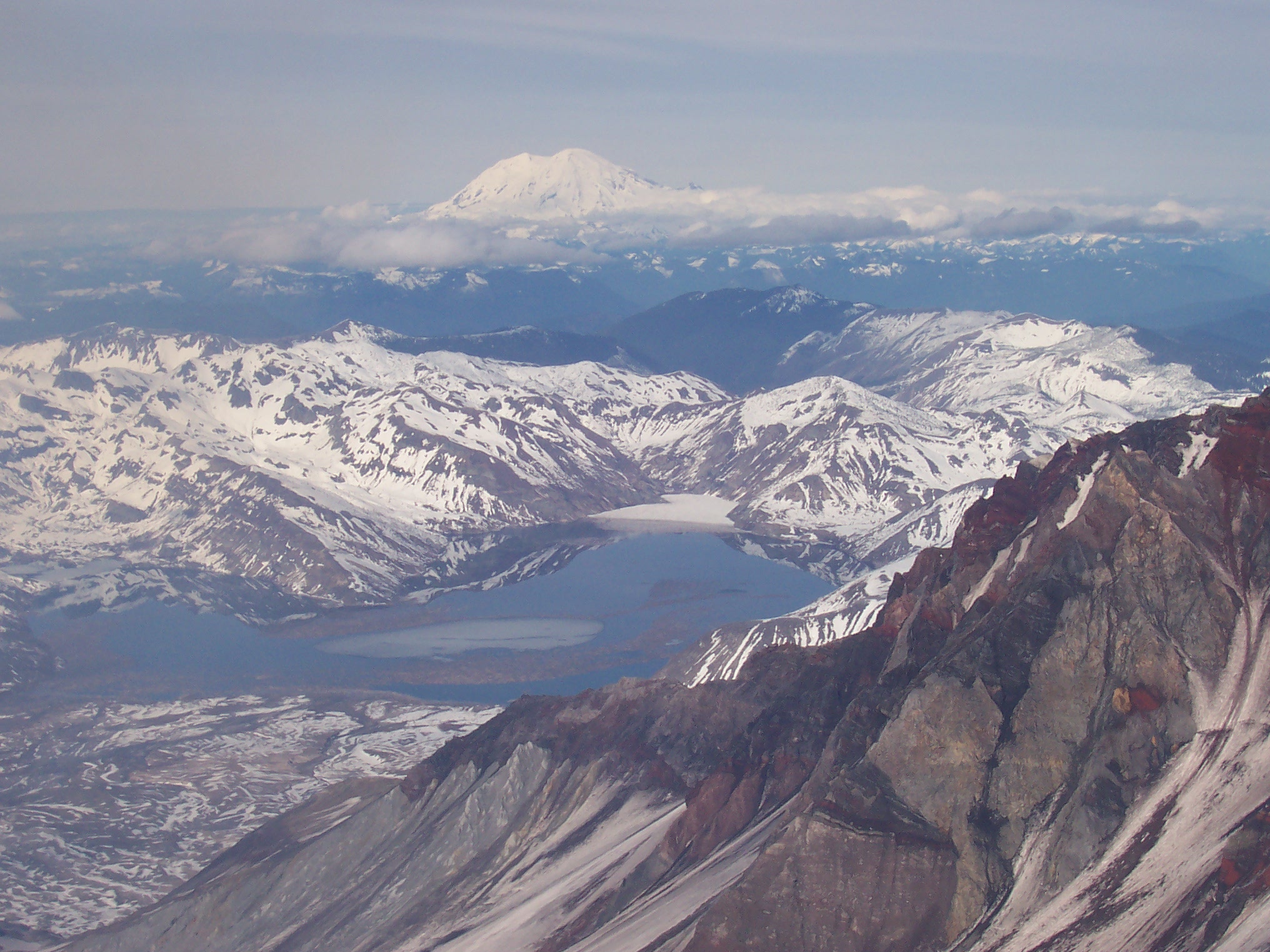
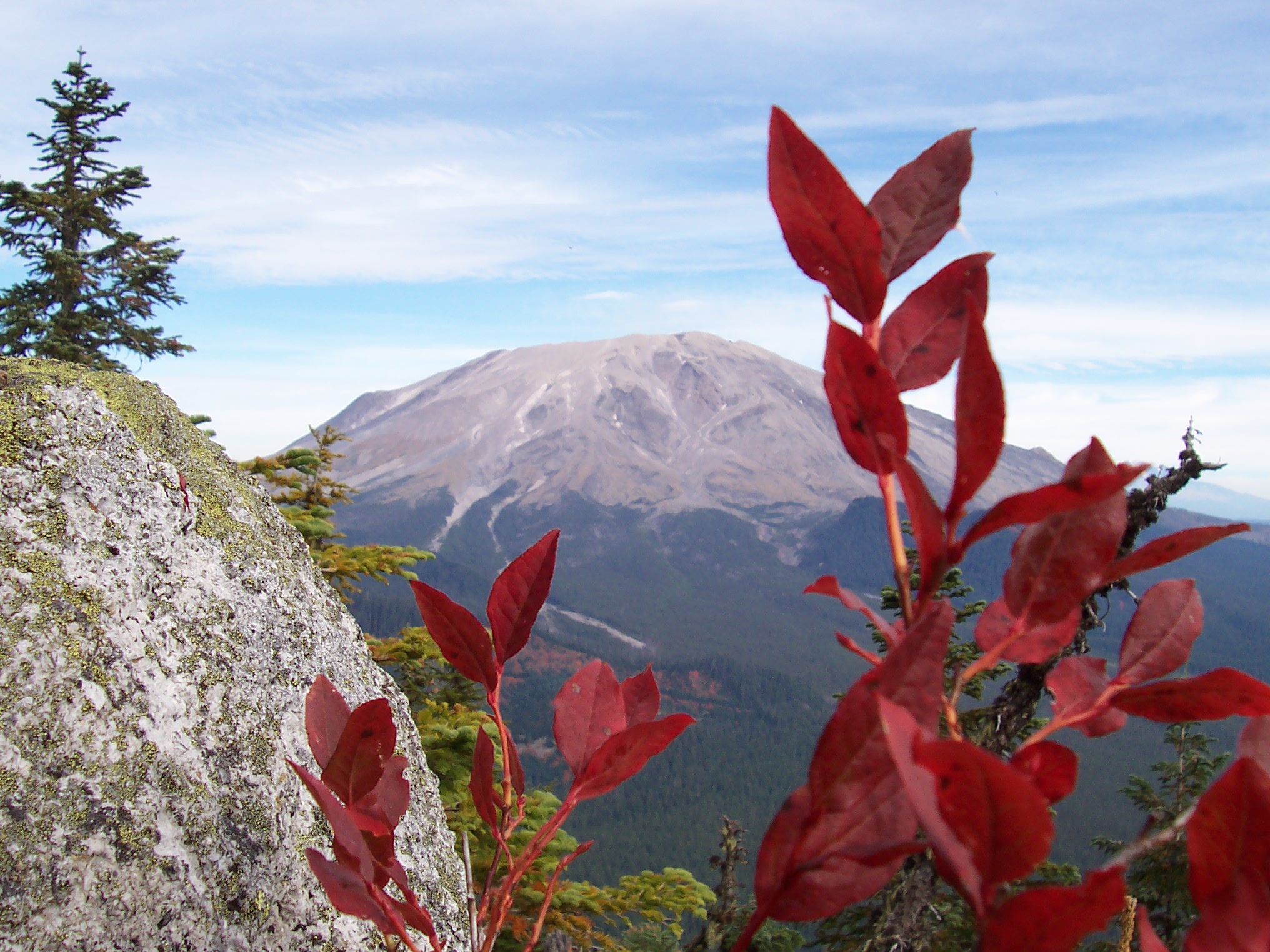
Leave A Comment